Fall is a time of crunchy leaves, pumpkin spice lattes and back-to-school stress. But perhaps most importantly, fall is the season where we come to openly express our love for the realm of the terrifying and the spooky.

Haunted houses take over abandoned buildings, TVs are bombarded with advertisements for Halloween candy and costumes, and theatres become chock-full of the latest horror releases — with some hits and some misses.
“I think often in horror, we’re willing to look at ugliness that other forms aren’t willing to look at.”
Jacqueline Baker
While horror becomes most visible around Halloween, it’s a genre that’s been around longer than any chainsaw-wielding madmen we might be familiar with. According to the New York Film Academy, horror’s golden age came about in the 1920s and 1930s.
Nosferatu (1922), Frankenstein (1932) and The Mummy (1932) are a small sampling of the kind of works that were being released at the time. As readers and watchers in the 21st century, a zombie or vampire flick might not top our lists as the best work of entertainment, but it’s important to note that at the time of their creation, these narratives were unrivalled in their originality and uniqueness.
Horror fan Kevin Martin notes how the horror genre has been marginalized over the years, as it grew and claimed the sphere of the weird and the unsightly. In addition to his personal love for horror, Martin has done work in Edmonton’s entertainment community to try and give the genre the esteemed position he believes it deserves.
Martin is the owner of The Lobby DVD Shop, an Edmonton-based video store specializing in cult horror and alternative films. He is also a member of the team behind organizing DEDfest, an alternative film festival in Edmonton that has been running for the past nine years.
“Horror movies have always been up and down as far as respect and love are concerned, and (there’s been) utter hatred and disgust from the moral right or the conservative kind of crowd,” Martin says.
Depending on the medium the best time for horror can vary, and for Martin, the height of horror in films is where he sees the genre best represented. “My personal golden age is the ‘70s and ‘80s. That’s the money,” he says.
Martin cites the works of directors like Wes Craven, Tobe Hooper and Sean S. Cunningham as being influential in making the era so memorable for fans of the genre.
Not only is horror an exceptional entertainment experience, it can also act as a powerful social force. “People can talk about real, political things going on in the world, but they can disguise them with monsters or something fantastical,” Martin says.
“These movies were beautifully shot,” he adds. “Even if you don’t understand what you’re watching, (you’re) captivated by the music or the imagery.”
The question to ask now is about the status of horror today and how originality is maintained, if at all.
For Martin and many horror fans, the rise in the number of remakes of original films is an alarming sign of the decline of the horror genre.
“Remakes today are just trying to cash in money-wise,” he says.
Although this decline is discouraging, Martin acknowledges that original, quality works are still being released, although barriers are large and numerous.
“There’s still good stuff coming out, but unfortunately you’re not going to get it from the studios that are owned by corporations that don’t care about creativity or trying to break new boundaries,” he says.
How do we move past this stagnation in the genre that has so accurately captured our worries and anxieties?
MacEwan English professor Jacqueline Baker is optimistic about the positive impact that the intersection between genre works and literary works have had and will continue to have on the resurgence of horror.
“(Horror) is not my background of study, but I’m a writer of horror,” Baker says. “I’ve loved it all of my life and studied it all of my life, informally, in both film and literature.”
Baker believes that a marriage between literary and horror works is proving to be a viable avenue for innovation in a genre that seems to be weighed down by heavy recycling of existing ideas and thoughts.
“I think we should demand as much from our horror writers as we do from our literary writers, so that’s why the particular melding of the two interests me,” she says.
As a social force, horror’s impact can’t be understated. “I think often in horror, we’re willing to look at ugliness that other forms aren’t willing to look at,” Baker says, adding that horror can act like a mirror for society to look into in order to understand and acknowledge its fears.
“We’re more content with our literature to have a neat ending, we want to see things tied up, we want to see that people are OK,” Baker says.
Horror seems to take this expectation of a tidy ending and turn it sideways and upside down, providing a view of the world that’s as disturbing as it is necessary.
When it comes to bringing originality and quality back into media that’s produced under the banner of horror, there seems to be no simple, concrete solution.
Growing up with horror and witnessing its cyclical nature and its many rises and falls, Martin is hopeful for a reclamation of the quality that has previously made itself known in the genre.
“I feel like I’m a pop culture teacher to the younger ones that come in,” Martin says. “Something is going to break through, but I really couldn’t tell you what.”
Cover illustration by Alley MacLean.





0 Comments